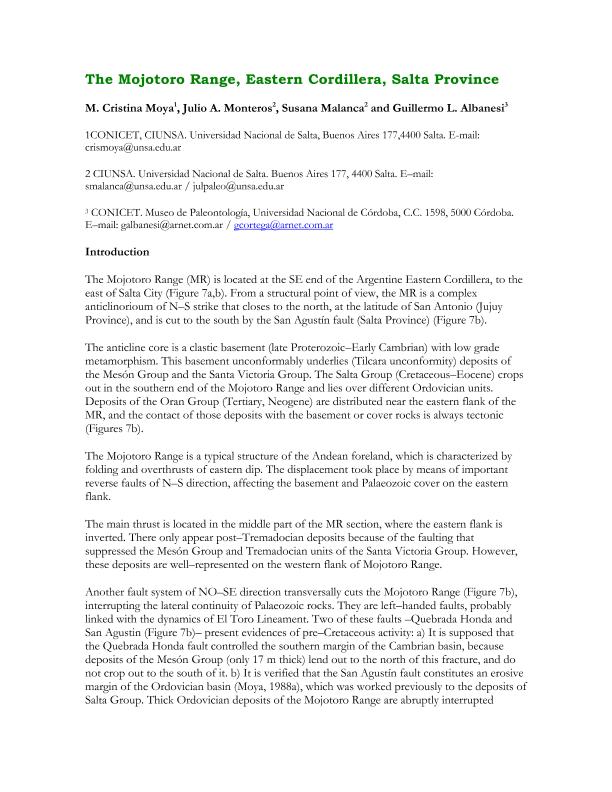Mostrar el registro sencillo del ítem
dc.contributor.author
Moya, Maria Cristina

dc.contributor.author
Monteros, Julio A.
dc.contributor.author
Malanca, Susana
dc.contributor.author
Albanesi, Guillermo Luis

dc.date.available
2021-06-17T18:33:50Z
dc.date.issued
2003
dc.identifier.citation
Moya, Maria Cristina; Monteros, Julio A.; Malanca, Susana; Albanesi, Guillermo Luis; The Mojotoro Range, eastern cordillera, Salta province; Universidad Nacional de Tucumán. Facultad de Ciencias Naturales e Instituto Miguel Lillo. Instituto Superior de Correlación Geológica; Serie Correlación Geológica; 11; 2003; 1-8
dc.identifier.issn
1514-4186
dc.identifier.uri
http://hdl.handle.net/11336/134131
dc.description.abstract
The Mojotoro Range (MR) is located at the SE end of the Argentine Eastern Cordillera, to the east of Salta City (Figure 7a,b). From a structural point of view, the MR is a complex anticlinorioum of N–S strike that closes to the north, at the latitude of San Antonio (Jujuy Province), and is cut to the south by the San Agustín fault (Salta Province) (Figure 7b). The anticline core is a clastic basement (late Proterozoic–Early Cambrian) with low grade metamorphism. This basement unconformably underlies (Tilcara unconformity) deposits of the Mesón Group and the Santa Victoria Group. The Salta Group (Cretaceous–Eocene) crops out in the southern end of the Mojotoro Range and lies over different Ordovician units. Deposits of the Oran Group (Tertiary, Neogene) are distributed near the eastern flank of the MR, and the contact of those deposits with the basement or cover rocks is always tectonic (Figures 7b). The Mojotoro Range is a typical structure of the Andean foreland, which is characterized by folding and overthrusts of eastern dip. The displacement took place by means of important reverse faults of N–S direction, affecting the basement and Palaeozoic cover on the eastern flank. The main thrust is located in the middle part of the MR section, where the eastern flank is inverted. There only appear post–Tremadocian deposits because of the faulting that suppressed the Mesón Group and Tremadocian units of the Santa Victoria Group. However, these deposits are well–represented on the western flank of Mojotoro Range. Another fault system of NO–SE direction transversally cuts the Mojotoro Range (Figure 7b), interrupting the lateral continuity of Palaeozoic rocks. They are left–handed faults, probably linked with the dynamics of El Toro Lineament. Two of these faults –Quebrada Honda and San Agustin (Figure 7b)– present evidences of pre–Cretaceous activity: a) It is supposed that the Quebrada Honda fault controlled the southern margin of the Cambrian basin, because deposits of the Mesón Group (only 17 m thick) lend out to the north of this fracture, and do not crop out to the south of it. b) It is verified that the San Agustín fault constitutes an erosive margin of the Ordovician basin (Moya, 1988a), which was worked previously to the deposits of Salta Group. Thick Ordovician deposits of the Mojotoro Range are abruptly interrupted against this fracture; toward the south, in the summits of Castillejo, the Salta Group covers the basement as well as few Ordovician tectonic sheets
dc.format
application/pdf
dc.language.iso
eng
dc.publisher
Universidad Nacional de Tucumán. Facultad de Ciencias Naturales e Instituto Miguel Lillo. Instituto Superior de Correlación Geológica
dc.rights
info:eu-repo/semantics/openAccess
dc.rights.uri
https://creativecommons.org/licenses/by-nc-sa/2.5/ar/
dc.subject
STRATIGRAPHY
dc.subject
PALEONTOLOGY
dc.subject
MOJOTORO RANGE
dc.subject
ARGENTINIAN EASTERN CORDILLERA
dc.subject.classification
Geología

dc.subject.classification
Ciencias de la Tierra y relacionadas con el Medio Ambiente

dc.subject.classification
CIENCIAS NATURALES Y EXACTAS

dc.title
The Mojotoro Range, eastern cordillera, Salta province
dc.type
info:eu-repo/semantics/article
dc.type
info:ar-repo/semantics/artículo
dc.type
info:eu-repo/semantics/publishedVersion
dc.date.updated
2021-06-07T16:50:19Z
dc.identifier.eissn
1666-9479
dc.journal.number
11
dc.journal.pagination
1-8
dc.journal.pais
Argentina

dc.journal.ciudad
San Miguel de Tucumán
dc.description.fil
Fil: Moya, Maria Cristina. Universidad Nacional de Salta. Consejo de Investigacion; Argentina. Consejo Nacional de Investigaciones Científicas y Técnicas. Centro Científico Tecnológico Conicet - Salta; Argentina
dc.description.fil
Fil: Monteros, Julio A.. Universidad Nacional de Salta. Consejo de Investigacion; Argentina
dc.description.fil
Fil: Malanca, Susana. Universidad Nacional de Salta. Consejo de Investigacion; Argentina
dc.description.fil
Fil: Albanesi, Guillermo Luis. Universidad Nacional de Córdoba. Facultad de Ciencias Exactas, Físicas y Naturales. Museo de Paleontología; Argentina. Consejo Nacional de Investigaciones Científicas y Técnicas. Centro Científico Tecnológico Conicet - Córdoba; Argentina
dc.journal.title
Serie Correlación Geológica
dc.relation.alternativeid
info:eu-repo/semantics/altIdentifier/url/http://www.insugeo.org.ar/scg/ver-articulo.php?id=201
Archivos asociados
